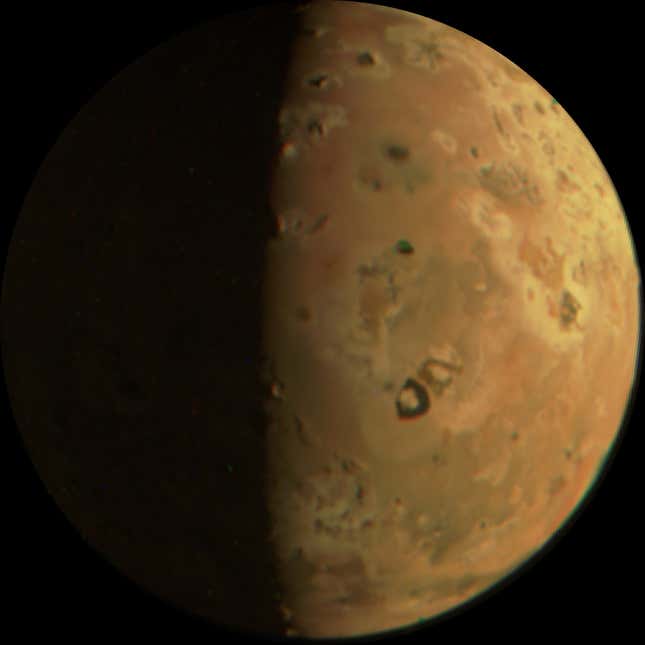The mutilated surface of Jupiter’s moon Io was revealed in great detail by the Juno spacecraft, which has been exploring the Jovian system since 2016 and recently pulled off the closest flyby of the volcanic world.
NASA’s Jupiter probe had its close encounter with Io on Saturday, December 30, flying at a distance of 930 miles (1,500 kilometers) away from its hellish surface. This marked not only the closest flyby of Io by Juno, but by any spacecraft in the past 20 years, according to NASA.
During this rare rendezvous, Juno captured intimate views of Jupiter’s moon using all three of its on board cameras. On Sunday, NASA released six images of the moon Io as seen by the spacecraft.

Jupiter’s rocky moon is the most volcanically active body in the solar system. As revealed in the new images, the surface of Io is mangled by hundreds of volcanoes and lakes of molten silicate lava that appear as burnt scarring across its tortured landscape. As the innermost of Jupiter’s four Galilean moons, Io is stuck between the planet’s immense gravitational force and the gravitational tug of its sister moons Europa and Ganymede. This contributes to the moon’s volcanic activity as Io is constantly being stretched and squeezed due to its position.
With its close flybys of Io, the team behind the Juno mission is investigating the source of the moon’s volcanic activity and hoping to find out whether it is harboring a magma ocean underneath its crust, according to NASA. The Juno science team will study how often the volcanoes on Io erupt, how bright and hot they are, and how the shape of the lava flow changes.
Io is also the main source of most of the charged particles in Jupiter’s magnetosphere, creating a donut-shaped cloud of ions and electrons that surround the planet. The cloud, known as Io Plasma Torus, is formed when the atmospheric gases escaping from Io are ionized. A group of scientists from the Southwest Research Institute in San Antonio, Texas, will also study how Io’s volcanic activity is connected to the flow of charged particles in Jupiter’s magnetosphere by combining Juno data with remote observations by the Hubble and Webb space telescopes.
In October, Juno captured an ominous view of Io, revealing its charred surface in the closest view of the moon thus far. Juno also captured a cozy family photo of Jupiter and Io in September, revealing the gas giant and its moon side by side.
Juno’s recent flyby of Io marked the spacecraft’s 57th orbit of the Jovian system, enduring years of radiation from the gas giant’s environment. “The cumulative effects of all that radiation has begun to show on JunoCam over the last few orbits,” Ed Hirst, project manager of Juno at NASA’s Jet Propulsion Laboratory, said in a statement. “Our engineering team has been working on solutions to alleviate the radiation damage and to keep the imager going.”
Juno is scheduled for a second close flyby of Io on February 3, in which the spacecraft will come within a distance of 930 miles (1,500 kilometers) from the moon’s surface.
For more spaceflight in your life, follow us on X (formerly Twitter) and bookmark Gizmodo’s dedicated Spaceflight page.

